Numerical Analysis of the Vertical Crown Displacements in Triple Adjacent Tunnels with Rock Bolts and Pipe Roofings
Abstract
:1. Introduction
2. Project Overview of the Case Study
2.1. Project Location and Scope
2.2. Tunnel Excavation
3. Numerical Simulation Model
3.1. Material Model
3.2. Material Parameters
3.3. Model Building Phase
3.4. Numerical Calculation Phase
- (a)
- Initial state: all initial states are defaulted, including the generation of geotechnical elements.
- (b)
- Construction of the two pilot tunnels’ pipe roofings: pipe roofings (12 m) are arranged above the top arch of the two pilot tunnels, as shown in Figure 10.
- (c)
- Excavation of the two pilot tunnels: excavate the soil (21@1.2 m, which means that each round length is 1.2 m, with a total of 21 round lengths) on the excavation surface and apply the lining of the plate elements, as shown in Figure 11.
- (d)
- Construction of the intermediate wall of two pilot tunnels: pour the concrete intermediate walls from the 1st to the 21st round and replace the soil with concrete elements.
- (e)
- Construction of the pipe roofings of the main tunnel: consistent with the construction of the two pilot tunnels, the pipe roofings (12@12 m) were simulated with embedded beams above the top arch.
- (f)
- MRT tunnel excavation: Excavate the soil body (21@1.2 m) on the excavation surface according to the sequence of the stepped excavation, apply the lining to the slab elements, and activate the rock bolts of the embedded beams. At the same time, remove half of the shotcrete, rock bolts, and pipe roofings in each of the east and west pilot tunnels, as shown in Figure 12.
- (g)
- Eastbound tunnel excavation: Excavate the soil body (21@1.2 m) on the excavation surface according to the sequence of the stepped excavation and apply the lining of the plate element. At the same time, remove the other half of the shotcrete, rock bolts, and pipe roofings in the east pilot tunnel.
- (h)
- Westbound tunnel excavation: Excavate the soil body (21@1.2 m) on the excavation surface according to the sequence of the stepped excavation and apply the lining of the slab elements. At the same time, remove the other half of the shotcrete, rock bolts, and pipe roofings in the west pilot tunnel.
4. Triple Adjacent Tunnel Excavation Analysis
4.1. Comparison of Analysis Results of the Mohr–Coulomb Model and Hoek–Brown Model
4.2. Comparison of Analytical Results between Tunnels with and without Bias Pressure
5. Discussion of Results
5.1. Pipe Roofing Installation Benefit Analysis
5.2. Rock Bolt Installation Benefit Analysis
6. Conclusions
- (1)
- The analysis performed for this study indicated that both constitutive models produced extremely similar results. From this point of view, both models could be applied to the rock formation in similar studies, provided that the analysis method, parameter conversion, and selection are appropriate.
- (2)
- The loading and deformation at various locations with and without bias pressure suggested that the maximum pipe roofing displacement occurred at the crown, and the closer to where the main tunnels and pilot tunnel met, the smaller the displacement, which could have been because the pipe roofings above took a certain portion of the vertical stresses. In the case of unbiased pressure, the displacement was clearly greater at the starting point (0 m) of the pipe roofings than that at the end (12 m). This could have been due to the distance from the excavation face and the excavation duration.
- (3)
- The comparison between cases with and without pipe roofings at various locations revealed that the pipe roofings could effectively reduce the displacement of the tunnel roof and side arches.
- (4)
- The comparison between cases with and without rock bolts at various locations revealed that the DRR was between 5.9% and 17.5%. This indicated that the installation of rock bolts could suppress the deformation around the sidewalls of the tunnels. Moreover, the installation of rock bolts also improved the overall stiffness of the rock mass.
- (5)
- For the crown of the westbound tunnel, the DRR for the pipe roofings was 8.3% and the DRR for the rock bolts was 11.7%. For the crown of the eastbound tunnel, the DRR for the pipe roofings was 12.1% and the DRR for the rock bolts was 13.8%. The results show that the effect of applying rock bolts was better than that of applying pipe roofings.
Author Contributions
Funding
Institutional Review Board Statement
Informed Consent Statement
Data Availability Statement
Acknowledgments
Conflicts of Interest
References
- Luo, Y.; Chen, J.; Liu, B.; Chen, L.; Xie, J. Analysis of Pipe-Roof in Tunnel Exiting Portal by the Foundation Elastic Model. Math. Probl. Eng. 2017, 2017, 9387628. [Google Scholar] [CrossRef] [Green Version]
- Li, L.P.; Lei, T.; Li, S.C.; Xu, Z.H.; Xue, Y.G.; Shi, S.S. Dynamic risk assessment of water inrush in tunnelling and software development. Geomech. Eng. 2015, 9, 57–81. [Google Scholar] [CrossRef]
- Sun, B.J.; Liu, Q.W.; Li, W.T.; Yang, X.Z.; Yang, B.; Li, T.C. Numerical implementation of rock bolts with yield and fracture behaviour under tensile-shear load. Eng. Fail. Anal. 2022, 139, 10646. [Google Scholar] [CrossRef]
- Li, J.; Tan, Z.; Yu, Y.; Ni, L. Analysis of deformation monitoring and mechanical behaviors of big pipe-roof for shallow buried large-span tunnel to underpass highway. J. Rock Mech. Eng. 2011, 30, 3002–3008. [Google Scholar]
- Hisatake, M.; Ohno, S. Effects of pipe roof supports and the excavation method on the displacements above a tunnel face. Tunn. Undergr. Space Technol. 2008, 23, 120–127. [Google Scholar] [CrossRef]
- Cheng, X.; Hong, T.; Lu, Z.; Cheng, X. Characterization of Underlying Twin Shield Tunnels Due to Foundation-Excavation Unloading in Soft Soils: An Experimental and Numerical Study. Appl. Sci. 2021, 11, 10938. [Google Scholar] [CrossRef]
- Huang, X.; Schweiger, H.F.; Huang, H.W. Influence of deep excavations on nearby existing tunnels. Int. J. Geomech. 2013, 13, 170–180. [Google Scholar] [CrossRef]
- Zhang, J.F.; Chen, J.J.; Wang, J.H.; Zhu, Y.F. Prediction of tunnel displacement induced by adjacent excavation in soft soil. Tunn. Undergr. Space Technol. 2013, 36, 24–33. [Google Scholar] [CrossRef]
- Zhang, X.H.; Wei, G.; Jiang, C.W. The study for longitudinal deformation of adjacent shield tunnel due to foundation pit excavation with consideration of the retaining structure deformation. Symmetry 2020, 12, 2103. [Google Scholar] [CrossRef]
- Han, K.; Wang, X.; Hou, B.; Lin, X.; Cao, C. Analysis of Instability Mode and Limit Support Pressure of Shallow Tunnel Face in Sands. Symmetry 2020, 12, 2067. [Google Scholar] [CrossRef]
- Carranza-Torres, C.; Fairhurst, C. Application of the convergence-confinement method of tunnel design to rock masses that satisfy the Hoek-Brown failure criterion. Tunn. Space Technol. 2000, 15, 187–213. [Google Scholar] [CrossRef]
- Luo, Y.B.; Chen, J.X.; Chen, Y.; Diao, P.S.; Qiao, X. Longitudinal deformation profile of a tunnel in weak rock mass by using the back analysis method. Tunn. Undergr. Space Technol. 2018, 71, 478–493. [Google Scholar] [CrossRef]
- Vlachopoulos, N.; Diederichs, M.S. Improved longitudinal displacement profiles for convergence confinement analysis of deep tunnels. Rock Mech. Rock Eng. 2009, 42, 131–146. [Google Scholar] [CrossRef]
- Song, S.G.; Li, S.C.; Li, L.P.; Zhang, Q.Q.; Wang, K.; Zhou, Y.; Liu, H.L. Study on longitudinal deformation profile of rock mass in a subsea tunnel. Mar. Georesour. Geotechnol. 2016, 34, 376–383. [Google Scholar] [CrossRef]
- Corbetta, F.; Bernaud, D.; Nguyen Minh, D.N. Contribution à la méthode convergence-confinement par le principe de la similitude. Rev. Franc. Geotech. 1991, 54, 5–11. (In French) [Google Scholar] [CrossRef] [Green Version]
- Panet, M. Understanding deformations in tunnels. Compr. Rock Eng. 1993, 1, 663–690. [Google Scholar]
- Fang, Q.; Wang, G.; Yu, F.; Du, J. Analytical algorithm for longitudinal deformation profile of a deep tunnel. J. Rock Mech. Geotech. Eng. 2021, 13, 845–854. [Google Scholar] [CrossRef]
- Brady, B.H.G.; Brown, E.T. Rock Mechanics for Underground Mining, 2nd ed.; Chapman and Hall: London, UK, 1993. [Google Scholar]
- Unlu, T.; Gercek, H. Effect of Poisson’s ratio on the normalized radial displacements occurring around the face of a circular tunnel. Tunn. Space Technol. 2003, 18, 547–553. [Google Scholar] [CrossRef]
- Prassetyo, S.H.; Gutierrez, M. Axisymmetric alternating direction explicit scheme for efficient coupled simulation of hydro-mechanical interaction in geotechnical engineering—Application to circular footing and deep tunnel in saturated ground. J. Rock Mech. Geotech. Eng. 2018, 10, 259–279. [Google Scholar] [CrossRef]
- Song, F.; Rodriguez-Dono, A.; Olivella, S.; Zhong, Z. Analysis and modelling of longitudinal deformation profiles of tunnels excavated in strain-softening time-dependent rock masses. Comput. Geotech. 2020, 125, 103643. [Google Scholar] [CrossRef]
- Chen, Y.; Li, C.C. Performance of fully encapsulated rebar bolts and D-Bolts under combined pull-and-shear loading. Tunn. Undergr. Space Technol. 2015, 45, 99–106. [Google Scholar] [CrossRef]
- Song, H.; Duan, Y.; Yang, J. Numerical simulation on bolted rock joints shearing performance. Min. Sci. Technol. 2010, 20, 460–465. [Google Scholar] [CrossRef]
- Ghadimi, M.; Shahriar, K.; Jalalifar, H. A new analytical solution for the displacement of fully grouted rock bolt in rock joints and experimental and numerical verifications. Tunn. Undergr. Space Technol. 2015, 50, 143–151. [Google Scholar] [CrossRef]
- Xie, X.; Zhao, M.; Shahrour, I. Face stability model for rectangular large excavations reinforced by pipe roofing. Tunn. Undergr. Space Technol. 2019, 94, 103132. [Google Scholar] [CrossRef]
- Yokota, Y.; Zhao, Z.; Nie, W.; Date, K.; Iwano, K.; Koizumi, Y.; Okada, Y. Development of a new deformation-controlled rock bolt: Numerical modelling and laboratory verification. Tunn. Undergr. Space Technol. 2020, 98, 103305. [Google Scholar] [CrossRef]
- Chen, J.; Li, D. Numerical simulation of fully encapsulated rock bolts with a tri-linear constitutive relation. Tunn. Undergr. Space Technol. 2022, 120, 104265. [Google Scholar] [CrossRef]
- Mahdi, M.; Shariatmadari, N. Construction Procedures Evaluation of Three Adjacent Tunnels and Excavation Step Effects. Int. J. Civ. Environ. Eng. 2014, 8, 86–90. [Google Scholar]
- Pande, G.N.; William, J.R. Numerical Methods in Rocks Mechanics; John Wiley and Sons Ltd.: Hoboken, NJ, USA, 1990. [Google Scholar]
- Chang, C.T.; Lee, M.C.; Hou, P.C. Design of twin-tube tunnel through soft rock. In Geotechnical Aspects of Underground Construction in Soft Ground; Mair, R.J., Taylor, R.N., Eds.; Balkema: Rotterdam, The Netherlands, 1996; pp. 251–255. [Google Scholar]
- Grasselli, G. 3D Behaviour of bolted rock joints:experimental and numerical study. Int. J. Rock Mech. Min. Sci. 2005, 42, 13–24. [Google Scholar] [CrossRef]
- Jalalifar, H.; Aziz, N. Analytical behaviour of bolt-joint intersection under lateral loading conditions. Rock Mech. Rock Eng. 2010, 43, 89–94. [Google Scholar] [CrossRef]
- Ahmad, A.; Ahirwar, N.; Sinha, M. New Austrian Tunneling Method (NATM) in Himalayan Geology: Emphasis on Execution Cycle Methodology. Int. J. Eng. Res. Technol. 2019, 8, 39–52. [Google Scholar]
- Robert, D.J. A Modified Mohr-Coulomb Model to Simulate the Behavior of Pipelines in Unsaturated Soils. Comput. Geotech. 2017, 91, 146–160. [Google Scholar] [CrossRef]
- Brinkgreve, R.B.J.; Kumarswamy, S.; Swolfs, W.M. Plaxis Material Models Manual; Plaxis B.V.: Delft, The Netherlands, 2017; pp. 35–53. [Google Scholar]
- Erik, E. The Hoek-Brown failure criterion. Rock Mech. Rock Eng. 2012, 45, 981–988. [Google Scholar]
- Hoek, E.; Brown, E.T. Empirical strength criterion for rock masses. J. Geotech. Eng. Div. 1980, 106, 1013–1035. [Google Scholar] [CrossRef]

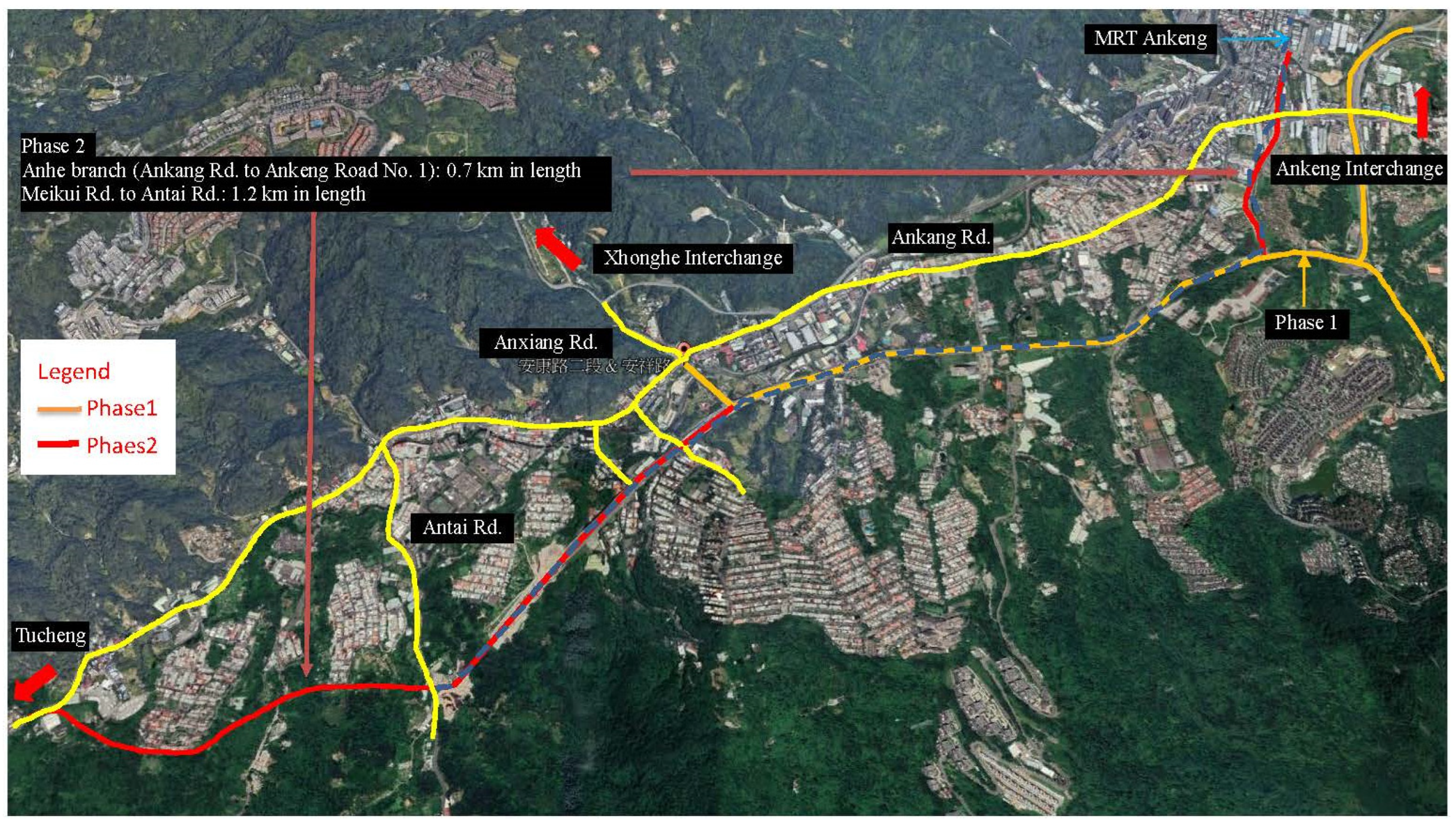
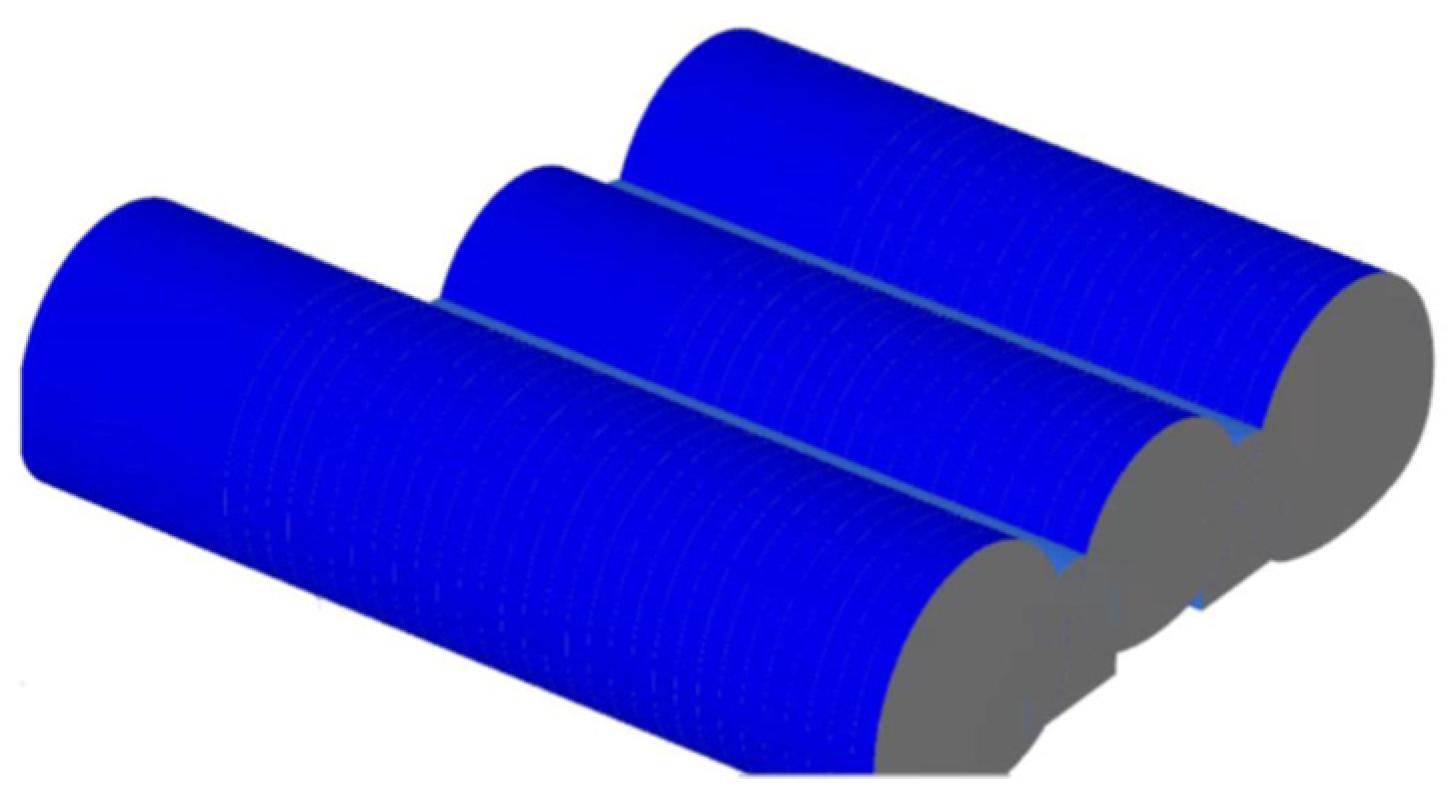

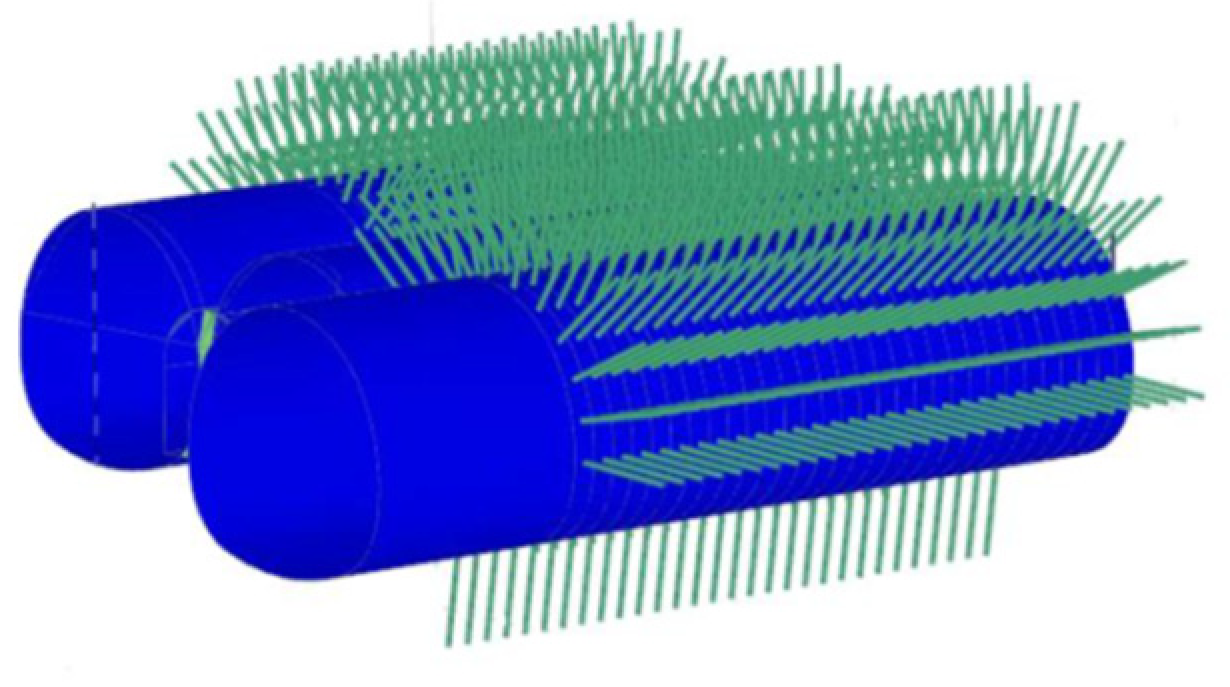
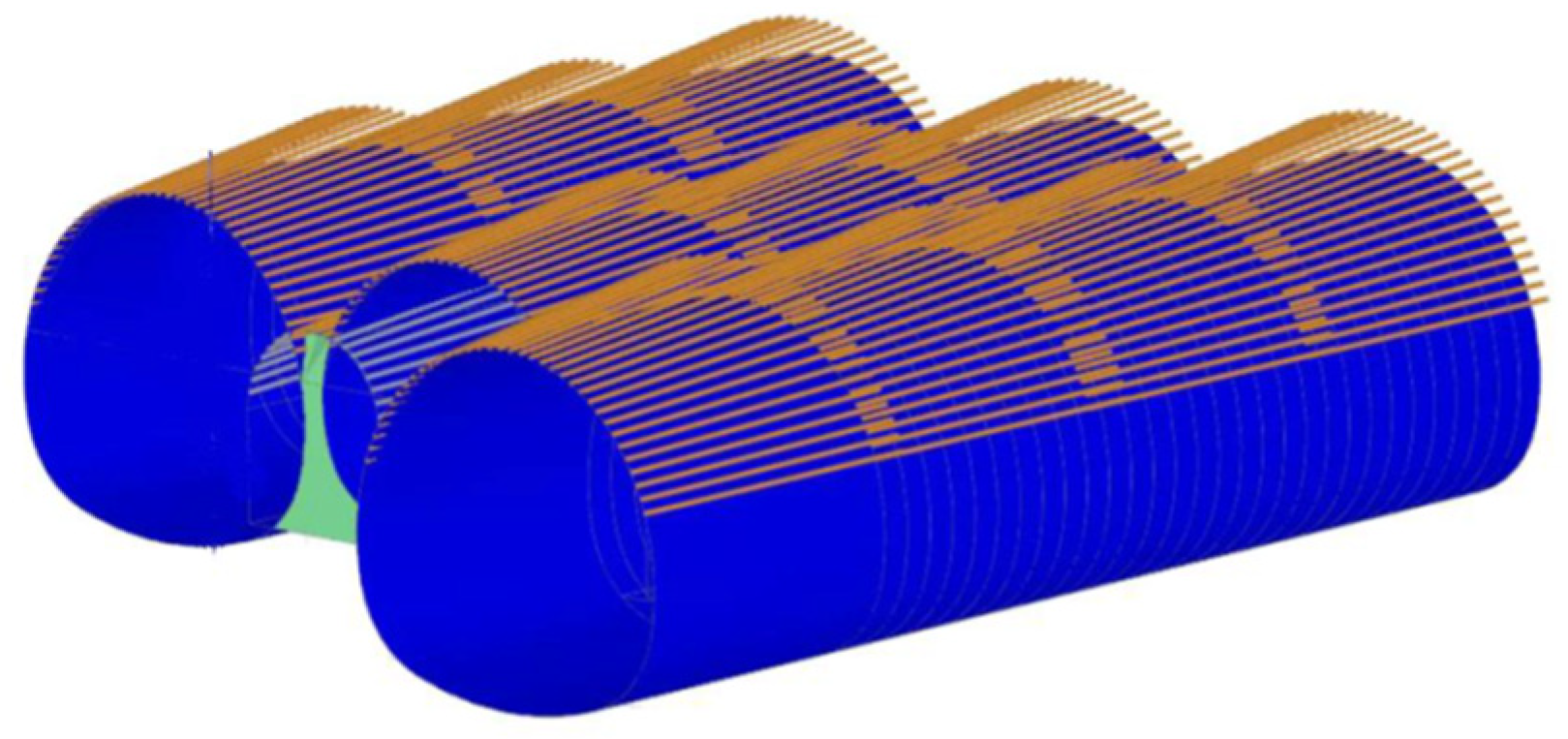
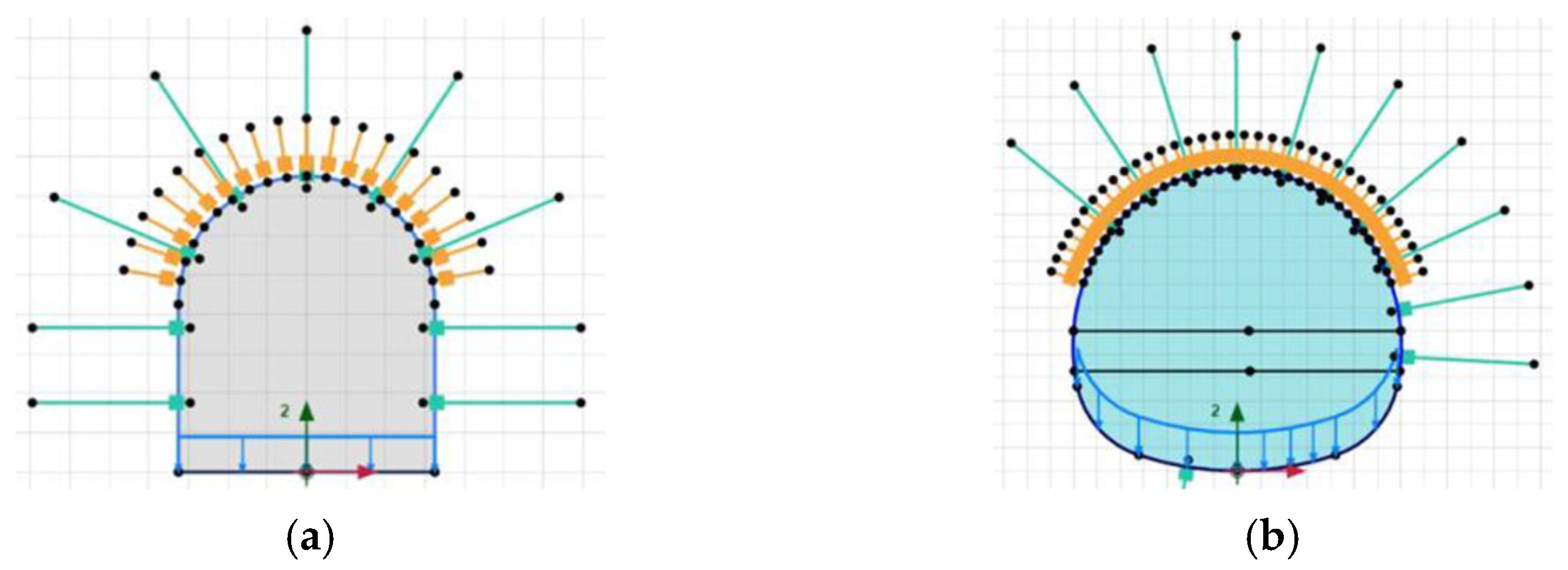


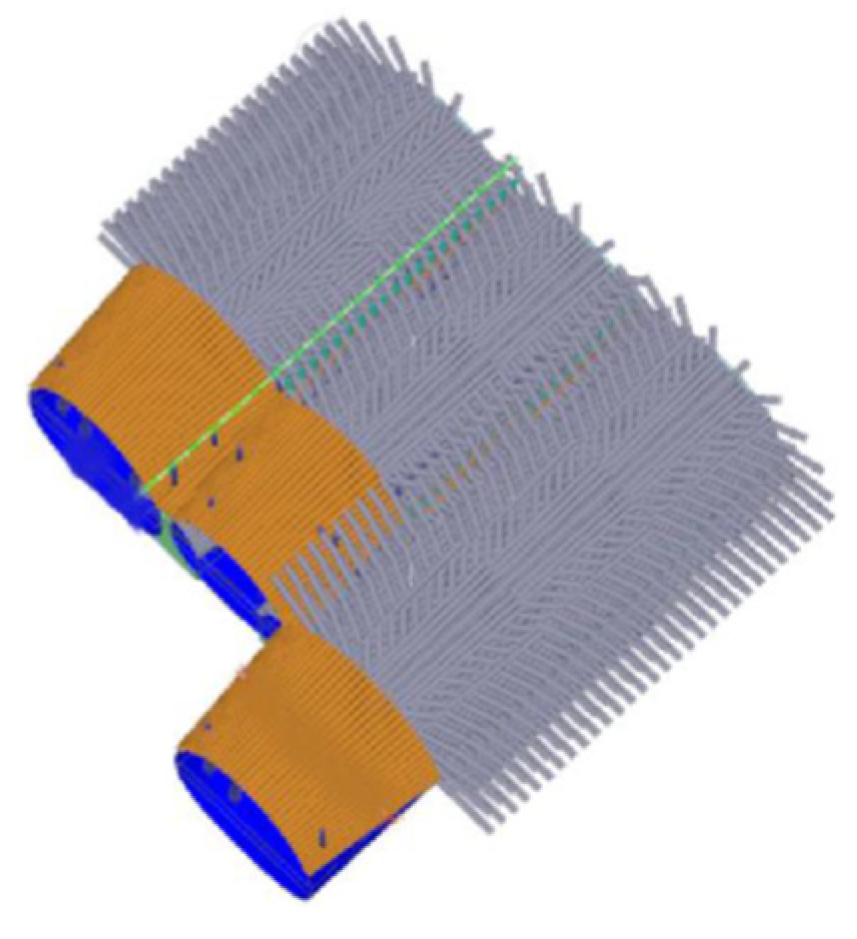
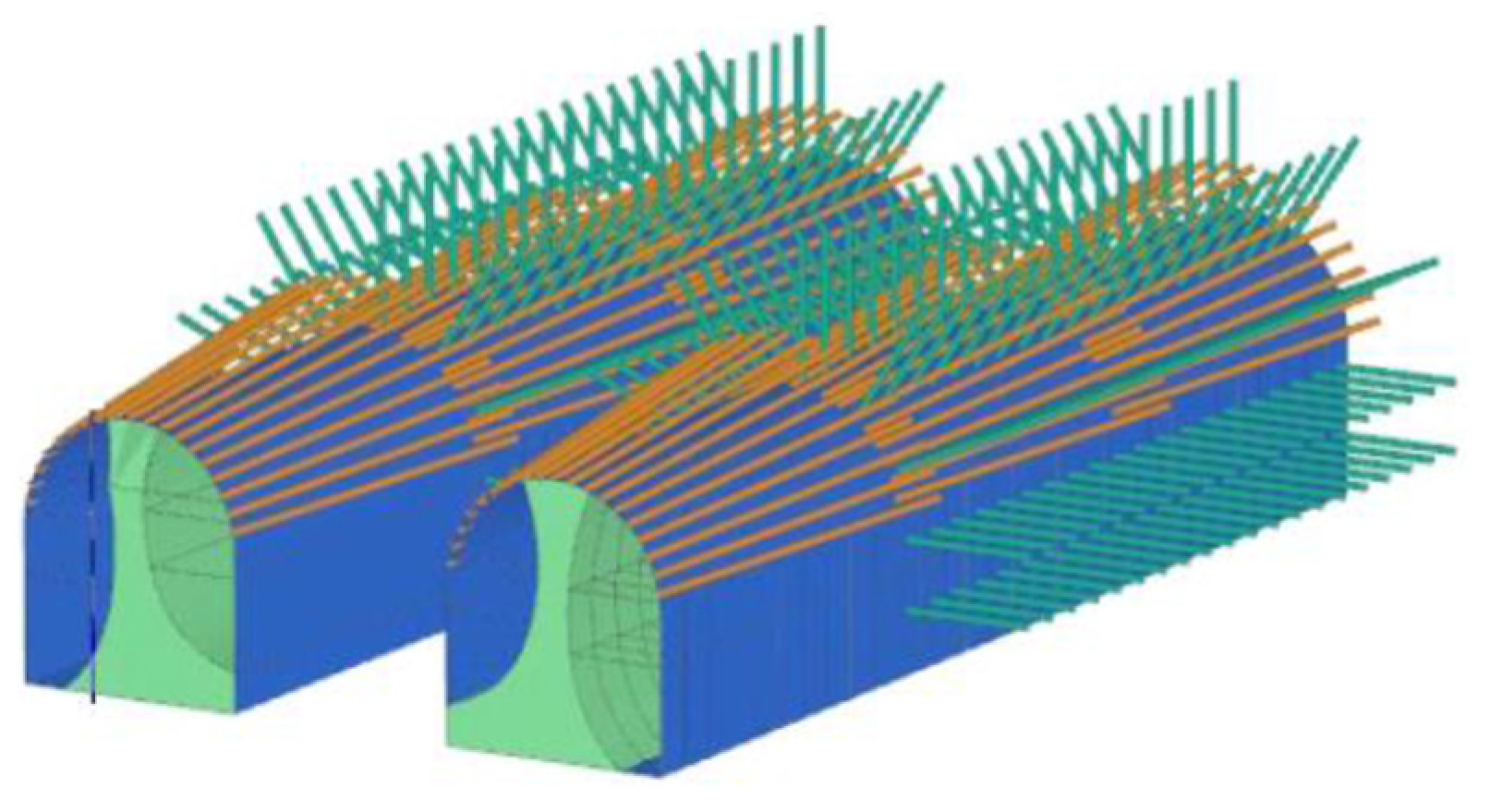
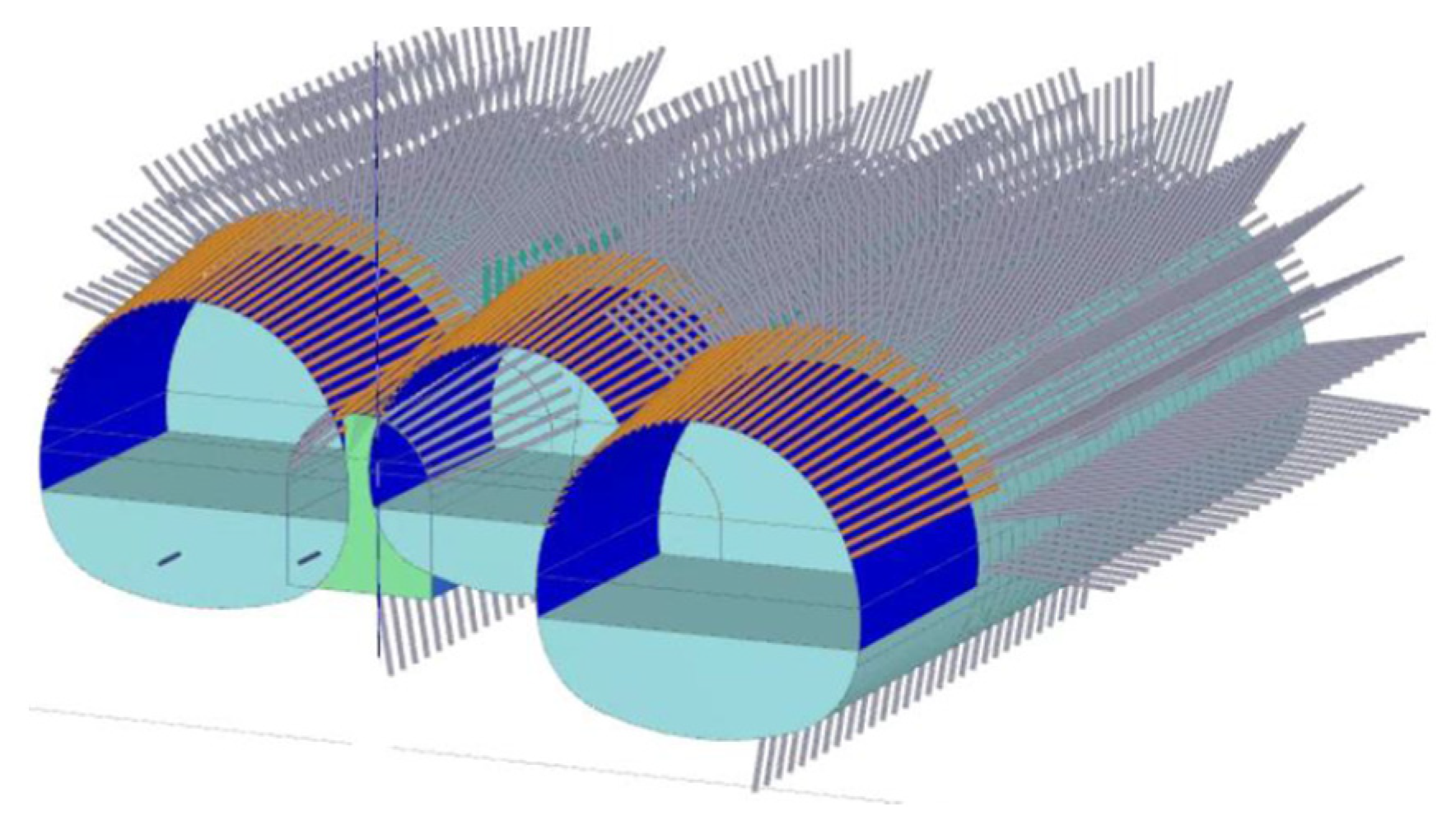
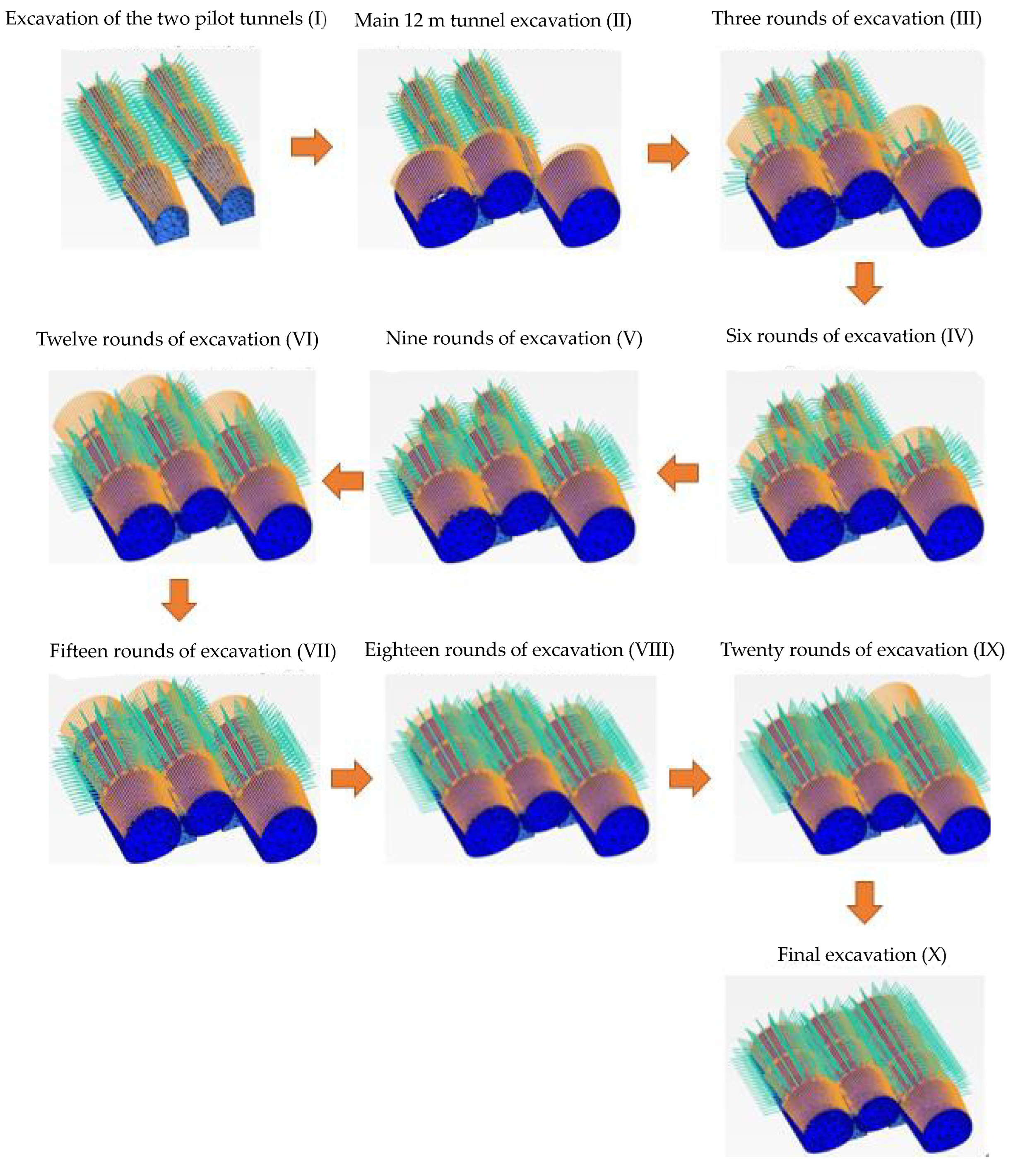
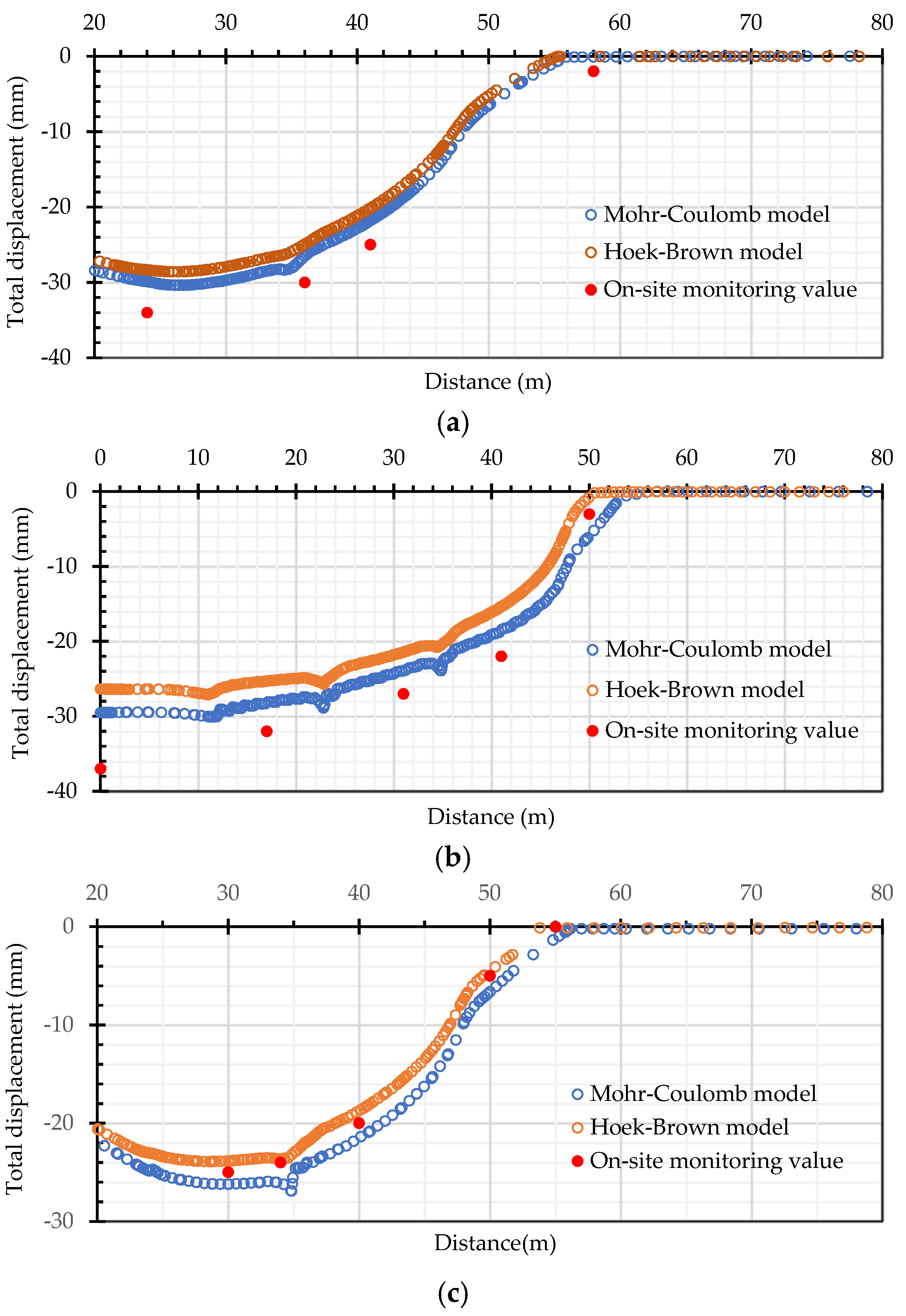
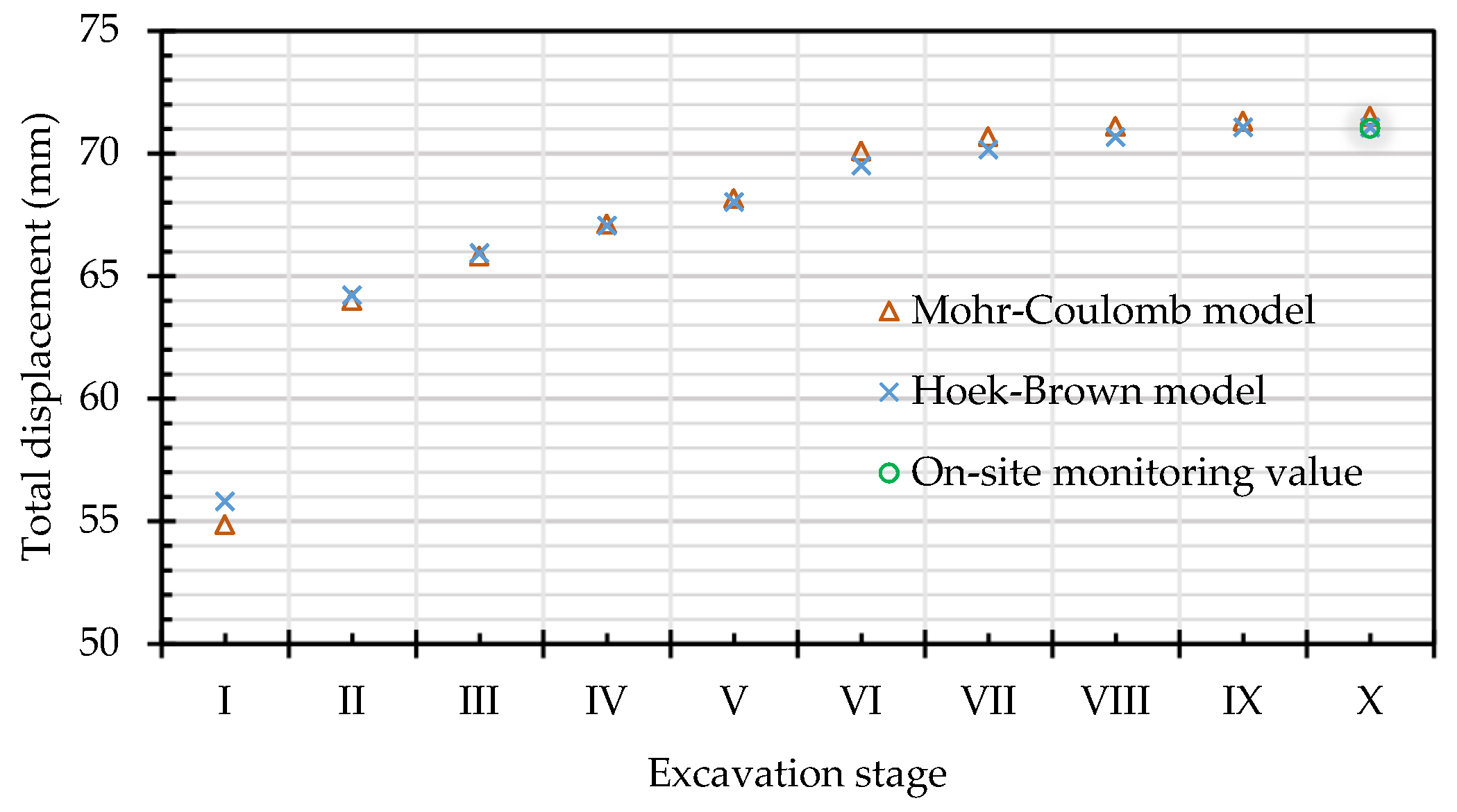
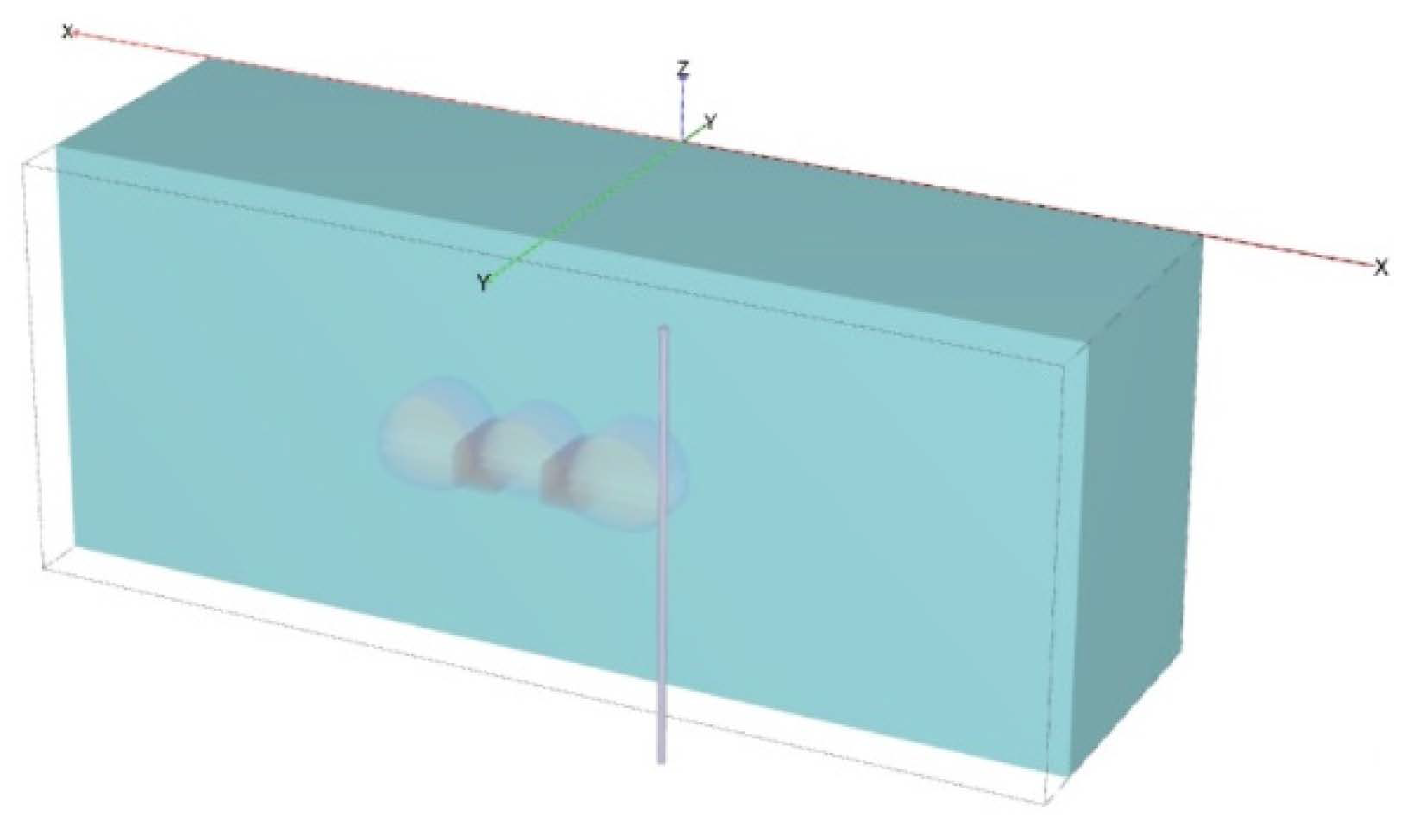
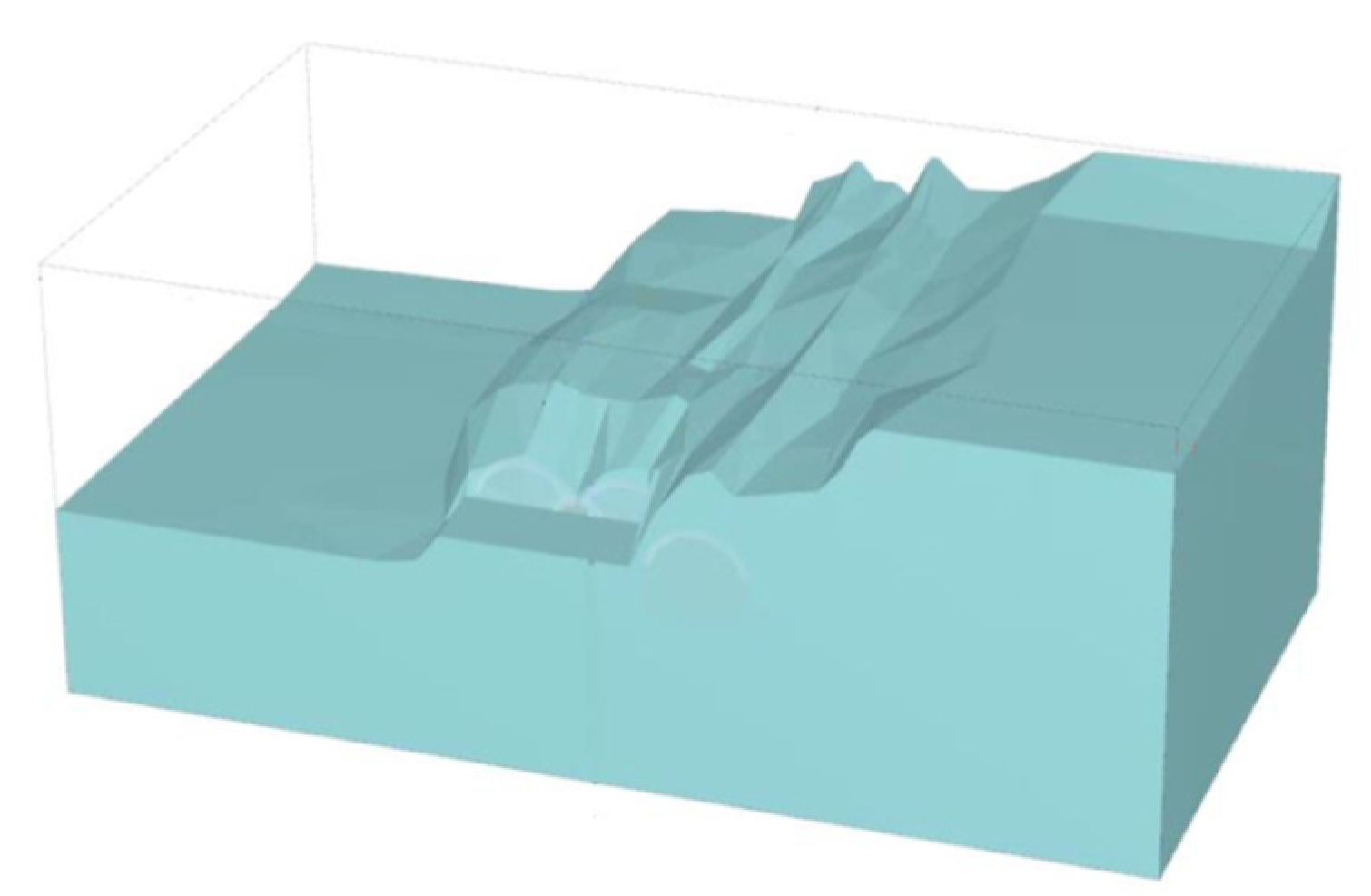

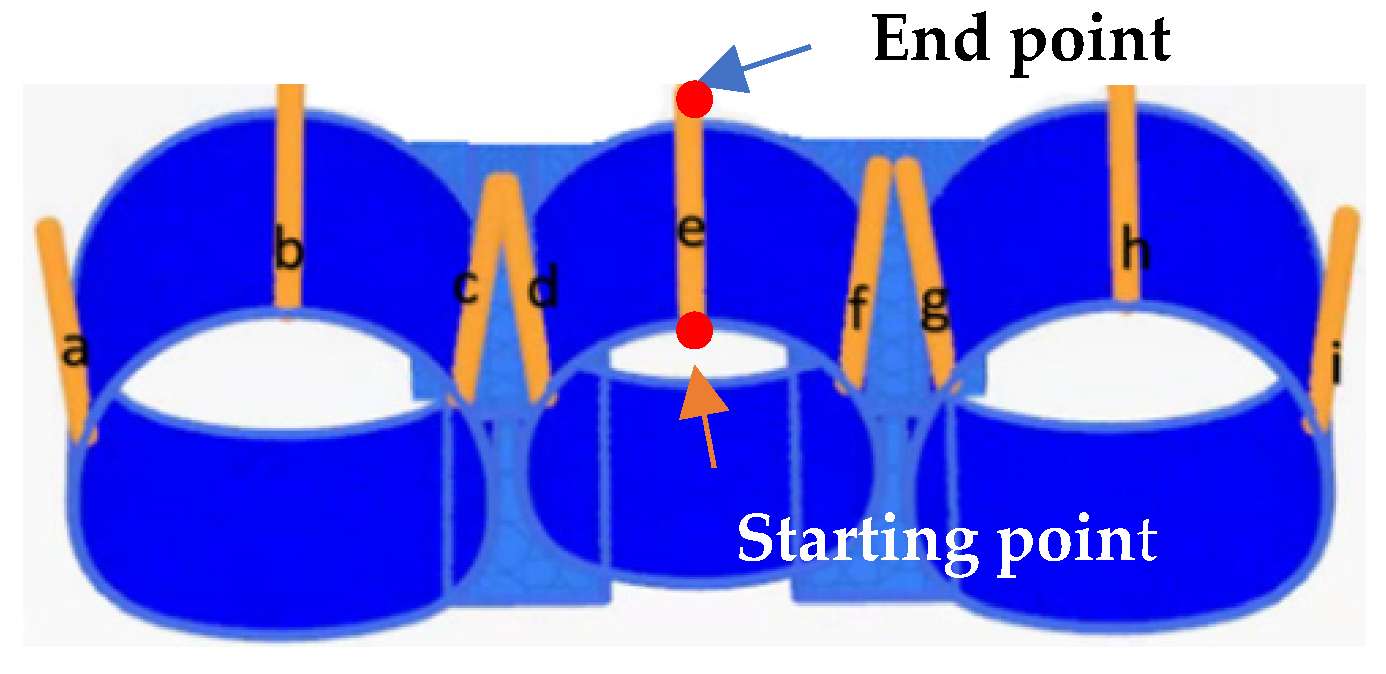


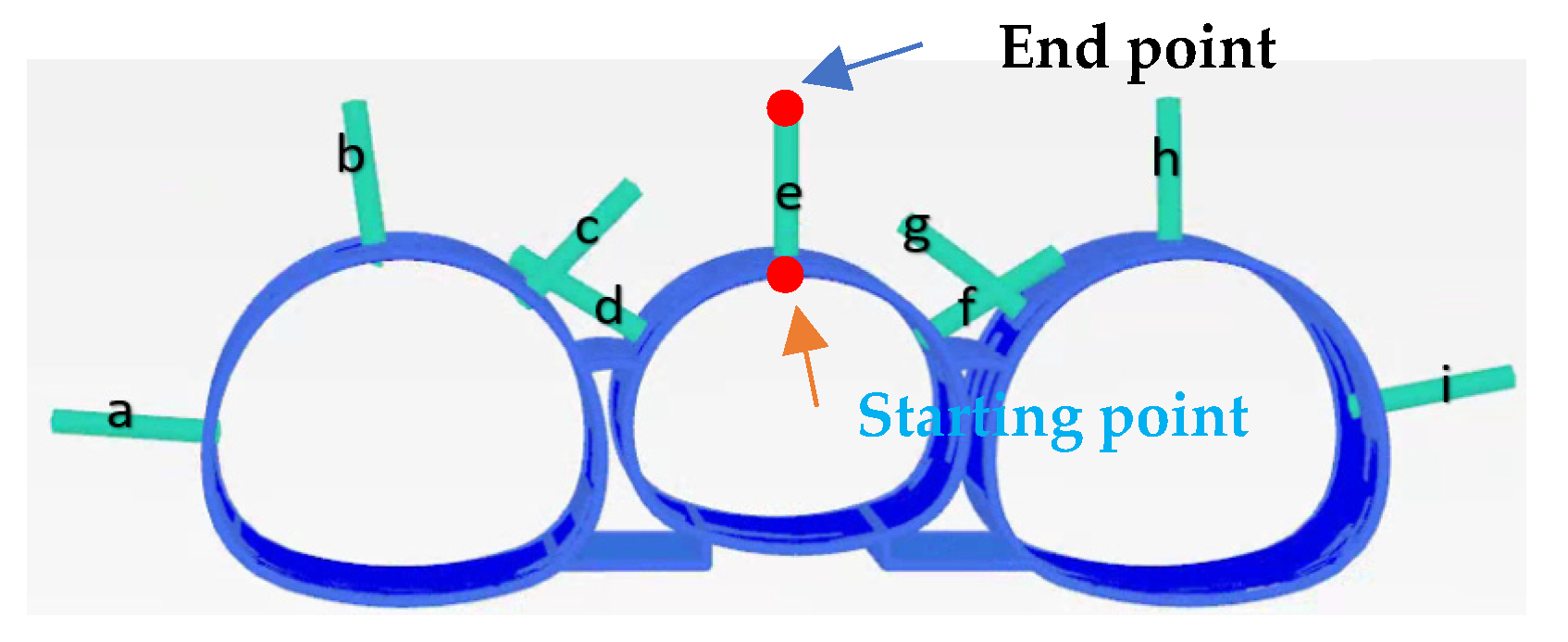



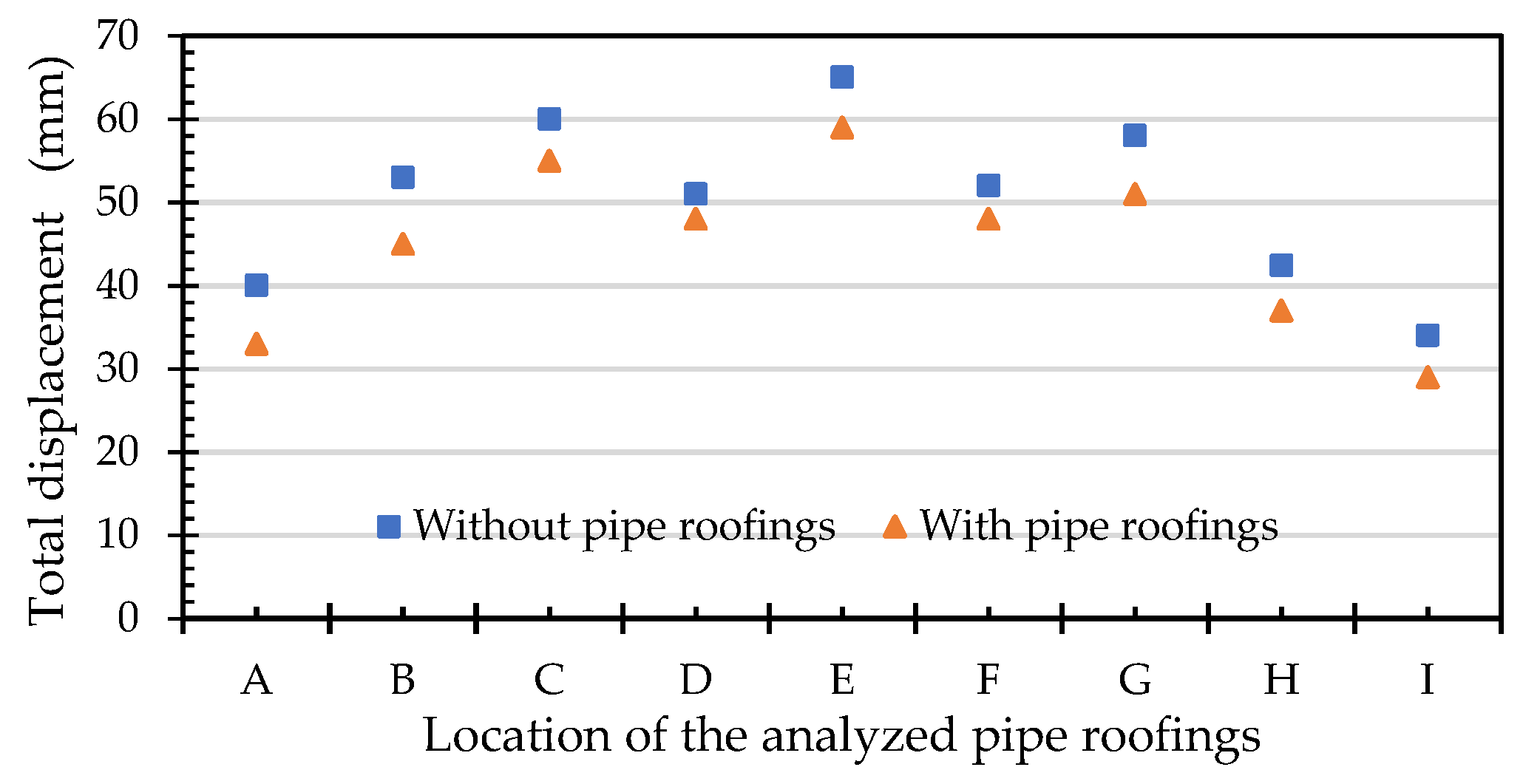
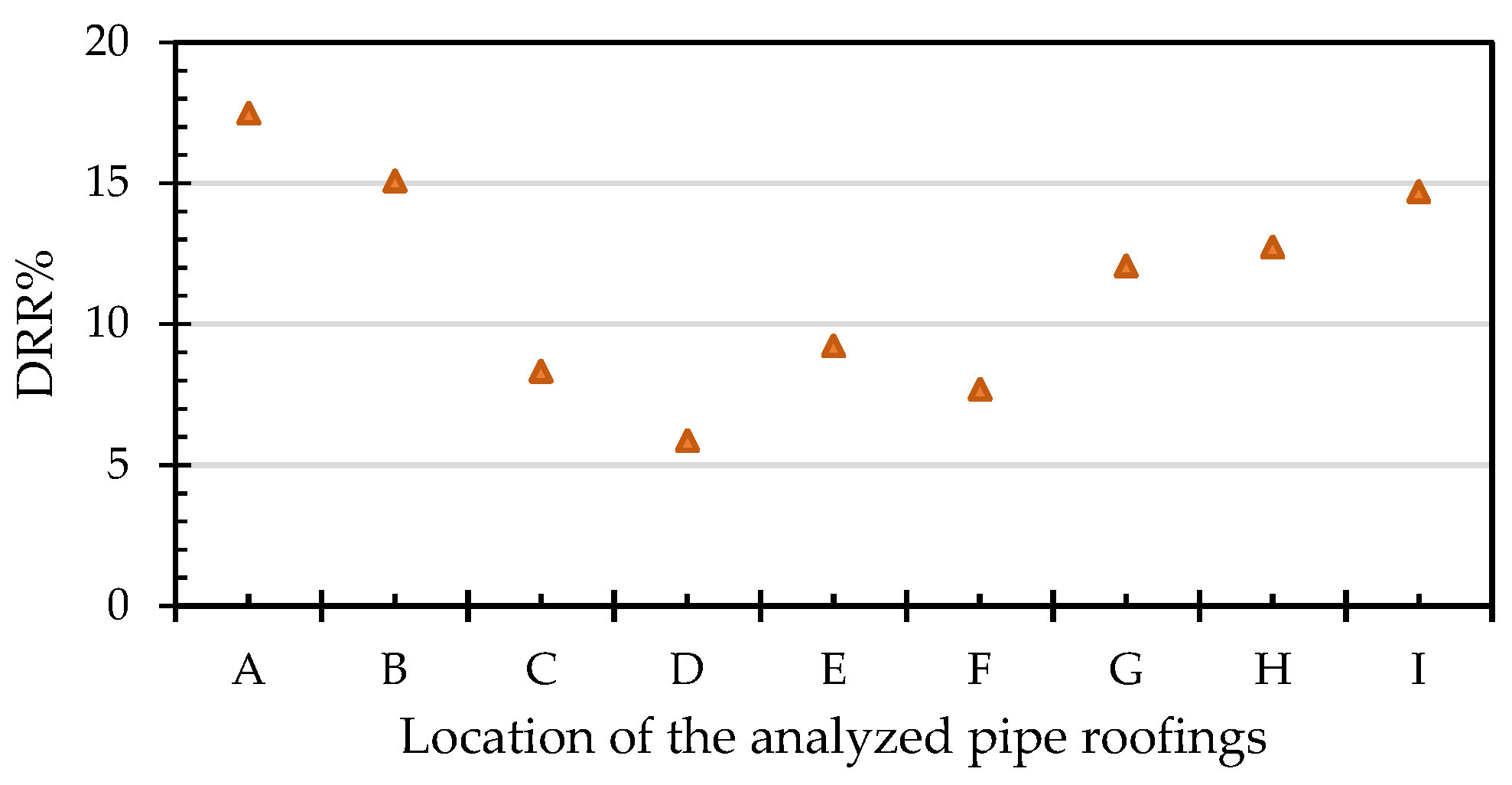
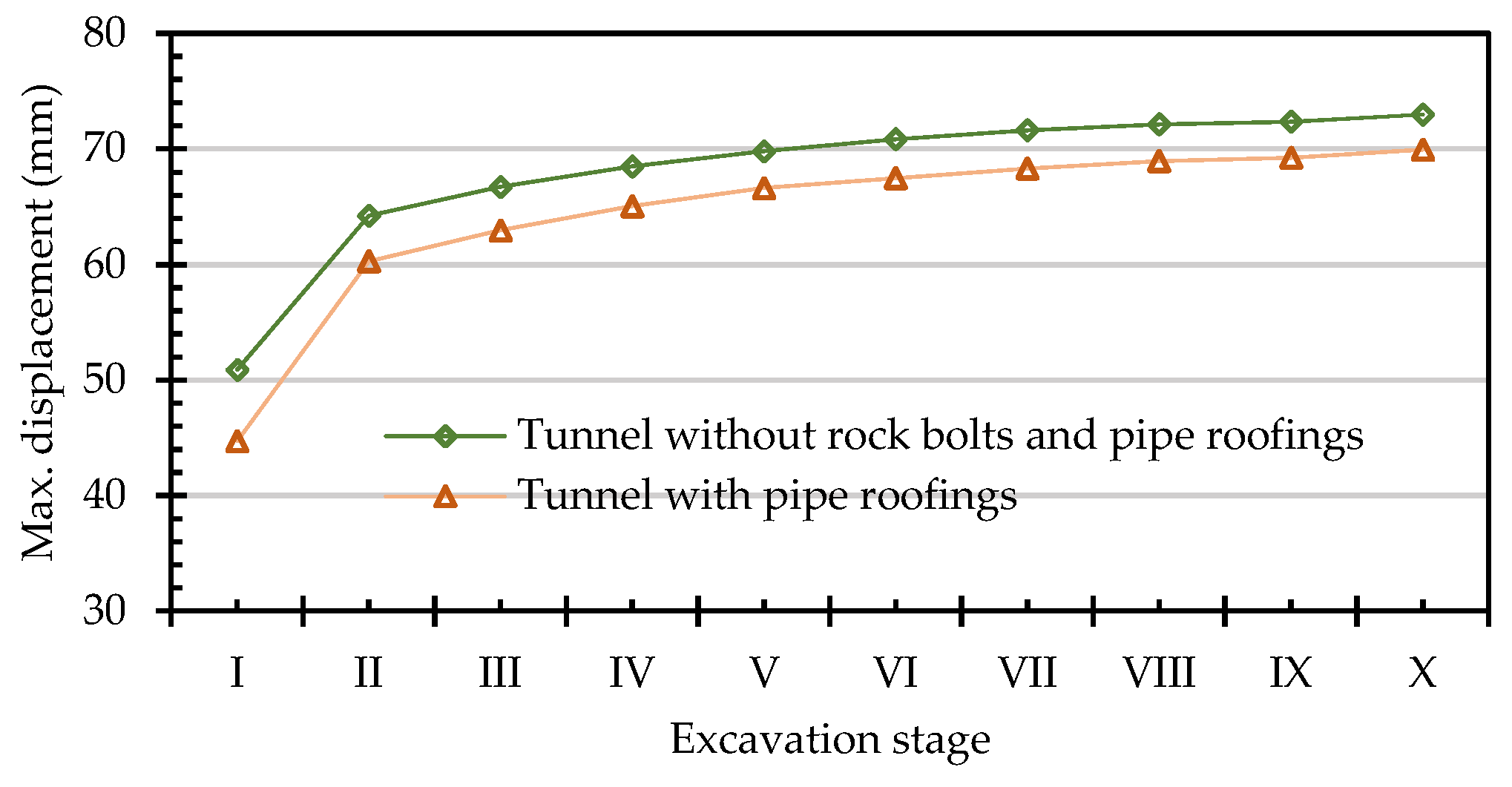
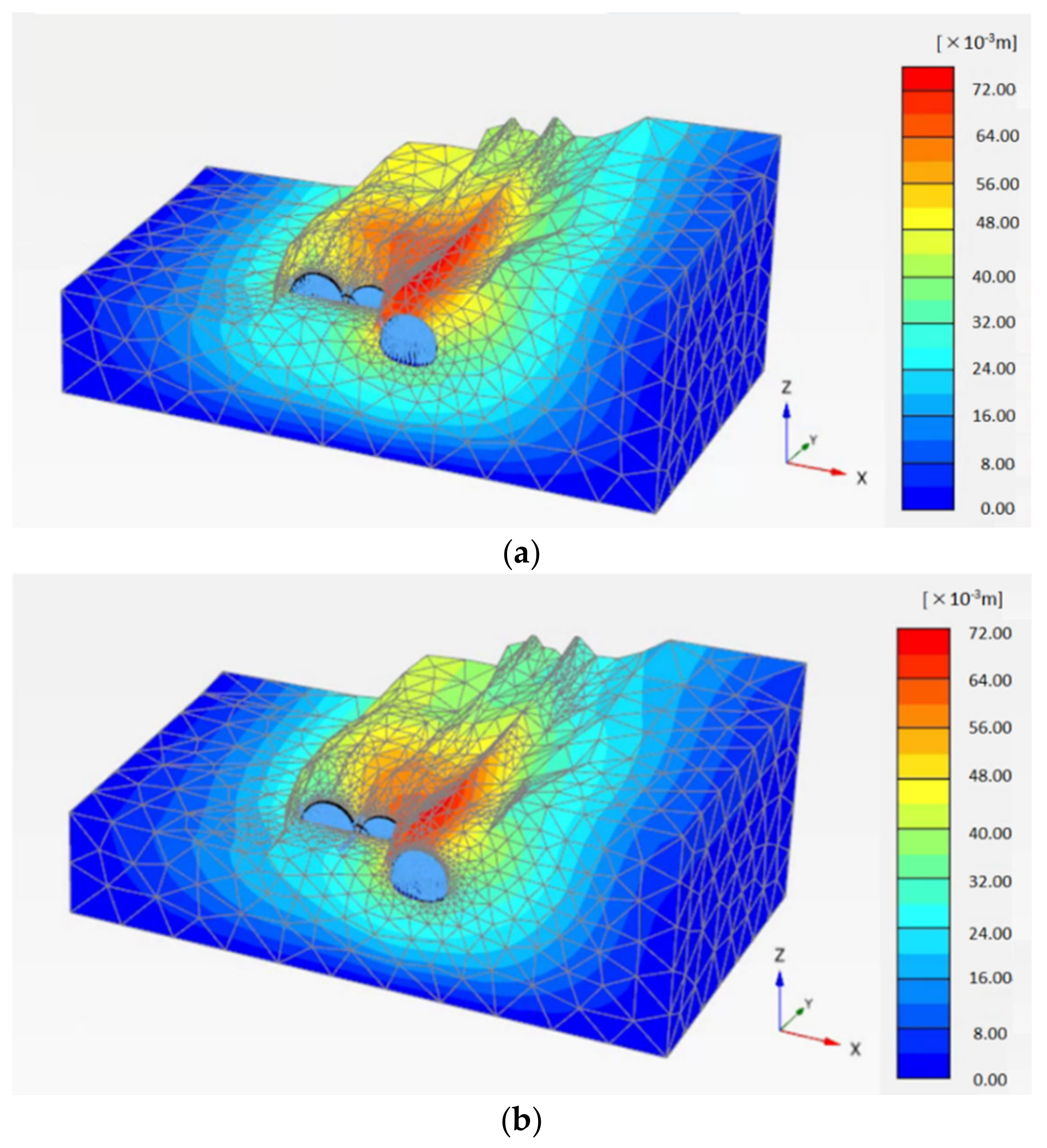


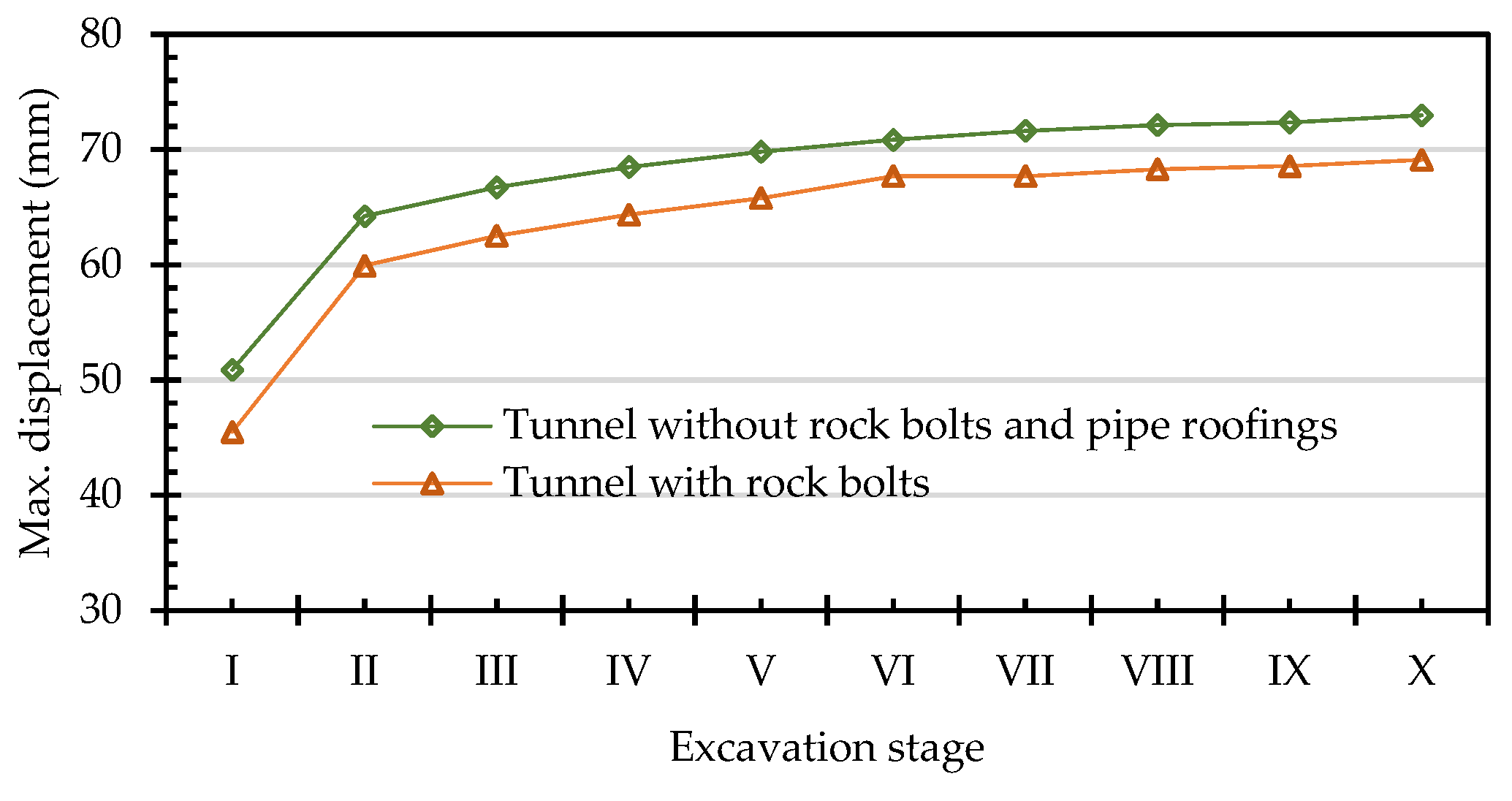
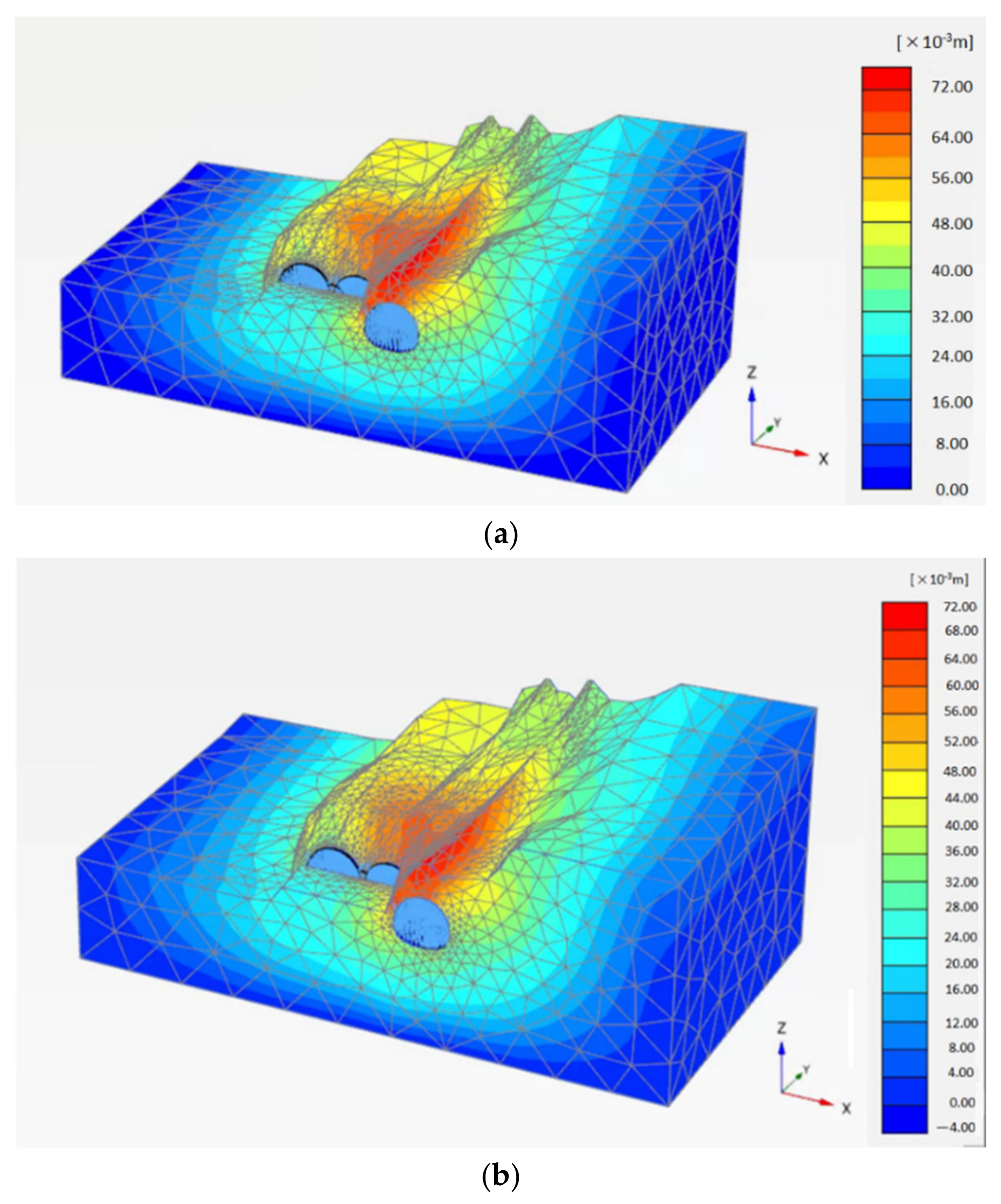
| Rock Parameters | Rock Layer |
|---|---|
| Unsaturated unit weight, γunsat (kN/m3) | 21 |
| Saturated unit weight, γsat (kN/m3) | 23 |
| Poisson’s ratio, ν | 0.25 |
| Young’s modulus, E (kN/m2) | 1.2 × 105 (1.0 × 105) |
| Cohesion strength, c (kN/m2) | 50 |
| Angle of friction, ϕ (°) | 32 |
| Dilatancy angle, Ψ (°) | 2 |
| Lateral stress coefficient, Ϋ0 | 0.5 |
| Rock Parameters | Rock Layer |
|---|---|
| Unsaturated unit weight, 𝛾unsat (kN/m3) | 21 |
| Saturated unit weight, 𝛾sat (kN/m3) | 23 |
| Poisson’s ratio, ν | 0.25 |
| Rock mass’s Young’s modulus, 𝐸rm (kN/m2) | 1.2 × 105 (1.0 × 105) |
| Uniaxial compressive strength of the intact rock, σc𝑖 (kN/m2) | 8000 |
| Intact rock mass parameter, 𝑚𝑖 | 13 |
| Geological Strength Index, GSI | 45 |
| Disturbance factor, D | 0.2 |
| Rock mass material constant, s | 0.00143 |
| Rock mass material constant, a | 0.508 |
| Lateral stress coefficient, 𝐾0 | 0.5 |
| Material Property | Pipe Roofing | Rock Bolt |
|---|---|---|
| Diameter (mm) | 70 | 23 |
| γ (kN/m3) | 76.93 | 76.93 |
| Spacing (m) | 0.5 | 2 |
| E (kN/m2) | 2.1 × 108 | 2.1 × 108 |
Publisher’s Note: MDPI stays neutral with regard to jurisdictional claims in published maps and institutional affiliations. |
© 2022 by the authors. Licensee MDPI, Basel, Switzerland. This article is an open access article distributed under the terms and conditions of the Creative Commons Attribution (CC BY) license (https://creativecommons.org/licenses/by/4.0/).
Share and Cite
Chen, S.-L.; Tsai, Y.-H.; Zhang, X.-L.; Tang, C.-W.; Hsu, Y.-Y. Numerical Analysis of the Vertical Crown Displacements in Triple Adjacent Tunnels with Rock Bolts and Pipe Roofings. Processes 2022, 10, 2062. https://doi.org/10.3390/pr10102062
Chen S-L, Tsai Y-H, Zhang X-L, Tang C-W, Hsu Y-Y. Numerical Analysis of the Vertical Crown Displacements in Triple Adjacent Tunnels with Rock Bolts and Pipe Roofings. Processes. 2022; 10(10):2062. https://doi.org/10.3390/pr10102062
Chicago/Turabian StyleChen, Shong-Loong, Yi-Hao Tsai, Xiao-Ling Zhang, Chao-Wei Tang, and Yu-Yun Hsu. 2022. "Numerical Analysis of the Vertical Crown Displacements in Triple Adjacent Tunnels with Rock Bolts and Pipe Roofings" Processes 10, no. 10: 2062. https://doi.org/10.3390/pr10102062
APA StyleChen, S.-L., Tsai, Y.-H., Zhang, X.-L., Tang, C.-W., & Hsu, Y.-Y. (2022). Numerical Analysis of the Vertical Crown Displacements in Triple Adjacent Tunnels with Rock Bolts and Pipe Roofings. Processes, 10(10), 2062. https://doi.org/10.3390/pr10102062







